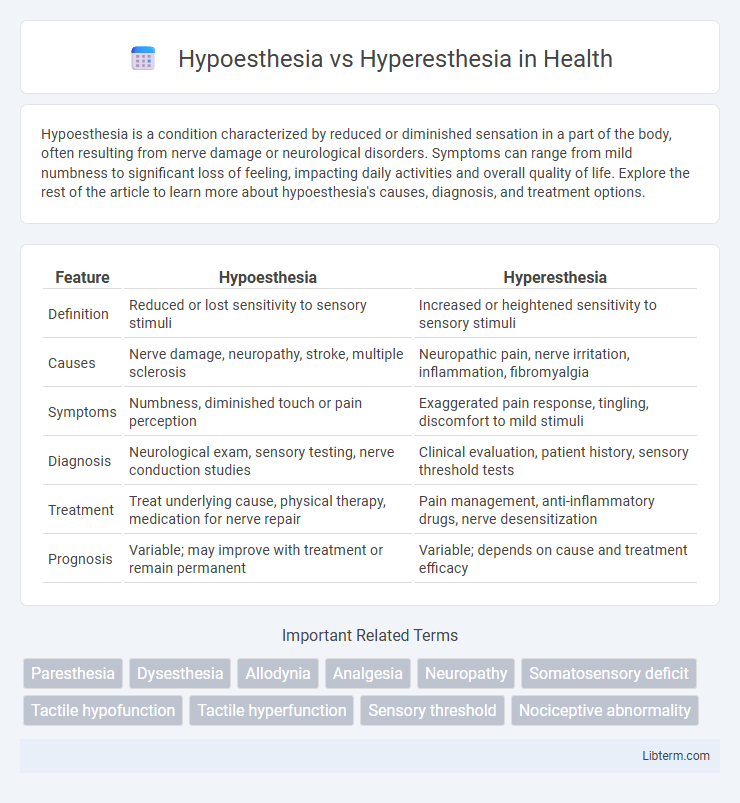Hypoesthesia is a condition characterized by reduced or diminished sensation in a part of the body, often resulting from nerve damage or neurological disorders. Symptoms can range from mild numbness to significant loss of feeling, impacting daily activities and overall quality of life. Explore the rest of the article to learn more about hypoesthesia's causes, diagnosis, and treatment options.
Table of Comparison
| Feature | Hypoesthesia | Hyperesthesia |
|---|---|---|
| Definition | Reduced or lost sensitivity to sensory stimuli | Increased or heightened sensitivity to sensory stimuli |
| Causes | Nerve damage, neuropathy, stroke, multiple sclerosis | Neuropathic pain, nerve irritation, inflammation, fibromyalgia |
| Symptoms | Numbness, diminished touch or pain perception | Exaggerated pain response, tingling, discomfort to mild stimuli |
| Diagnosis | Neurological exam, sensory testing, nerve conduction studies | Clinical evaluation, patient history, sensory threshold tests |
| Treatment | Treat underlying cause, physical therapy, medication for nerve repair | Pain management, anti-inflammatory drugs, nerve desensitization |
| Prognosis | Variable; may improve with treatment or remain permanent | Variable; depends on cause and treatment efficacy |
Introduction to Hypoesthesia and Hyperesthesia
Hypoesthesia refers to a diminished sense of touch or sensation, often resulting from nerve damage, neurological disorders, or localized trauma. Hyperesthesia indicates an increased sensitivity to sensory stimuli, commonly observed in cases of nerve irritation, inflammatory conditions, or certain neuropathies. Both conditions affect sensory perception but differ significantly in symptom presentation and underlying causes.
Defining Hypoesthesia: Meaning and Causes
Hypoesthesia refers to a reduced sense of touch or sensation, often manifesting as numbness or diminished sensitivity in specific body areas. This condition commonly arises from nerve damage, neurological disorders, or trauma affecting sensory pathways. Identifying hypoesthesia involves clinical evaluation to determine underlying causes such as peripheral neuropathy, multiple sclerosis, or localized nerve compression.
Understanding Hyperesthesia: Explanation and Triggers
Hyperesthesia is characterized by an increased sensitivity to sensory stimuli, resulting in heightened perception of touch, sound, or light. Common triggers include nerve injuries, certain neurological disorders, and exposure to irritants that amplify sensory nerve responses. Understanding hyperesthesia involves recognizing how abnormal nerve excitability leads to exaggerated sensory signals affecting daily comfort and function.
Key Differences between Hypoesthesia and Hyperesthesia
Hypoesthesia is characterized by a diminished or lost sense of touch or sensation, often caused by nerve damage or neurological disorders, leading to numbness or reduced sensitivity. Hyperesthesia involves an increased sensitivity to stimuli, resulting in heightened or exaggerated sensory perception, commonly associated with conditions like neuropathic pain or inflammation. The key difference lies in sensory response: hypoesthesia denotes a decreased sensation, whereas hyperesthesia represents an amplified sensory experience.
Common Symptoms of Hypoesthesia
Common symptoms of hypoesthesia include numbness, reduced tactile sensitivity, and a diminished ability to perceive pain or temperature changes, often resulting from nerve damage or neurological conditions. Patients may experience a decreased sensation in specific body regions such as the hands, feet, or face, impairing their ability to detect stimuli like touch or vibration. These sensory deficits differentiate hypoesthesia from hyperesthesia, which is characterized by increased sensitivity and heightened response to stimuli.
Typical Signs of Hyperesthesia
Hyperesthesia is characterized by an increased sensitivity to sensory stimuli, often presenting as heightened touch, pain, or temperature perception that exceeds normal response thresholds. Typical signs include exaggerated reactions to light touch, discomfort from mild tactile stimuli, and hypersensitivity to sound or light. These symptoms contrast with hypoesthesia, where sensory perception is diminished or lost.
Diagnostic Approaches for Sensory Disorders
Diagnostic approaches for sensory disorders involving hypoesthesia and hyperesthesia primarily include quantitative sensory testing (QST) to measure thresholds for touch, pain, and temperature. Electrophysiological studies, such as nerve conduction velocity (NCV) and somatosensory evoked potentials (SSEPs), help assess nerve function and pinpoint localized sensory deficits. Advanced imaging techniques like MRI and high-resolution ultrasound support differential diagnosis by visualizing nerve structure and ruling out central nervous system lesions.
Treatment Options for Hypoesthesia
Treatment options for hypoesthesia primarily involve addressing the underlying cause, such as nerve compression, diabetic neuropathy, or traumatic injury. Physical therapy, medications like anticonvulsants or corticosteroids, and in some cases surgical interventions to relieve nerve pressure can improve sensory function. Emerging therapies include neurostimulation and regenerative medicine approaches aimed at restoring nerve health and reducing sensory deficits.
Management Strategies for Hyperesthesia
Management strategies for hyperesthesia primarily involve addressing the underlying cause, such as neuropathic pain or skin disorders, with medications like anticonvulsants, antidepressants, and topical agents including capsaicin or lidocaine. Physical therapy and desensitization techniques help reduce sensory hypersensitivity by gradually exposing affected areas to stimuli. Behavioral approaches, including stress reduction and cognitive-behavioral therapy, support symptom control by modulating central nervous system sensitivity.
When to Seek Medical Help for Sensory Changes
Seek medical help for hypoesthesia or hyperesthesia if sensory changes persist beyond a few days, worsen, or interfere with daily activities. Sudden onset of numbness, burning sensations, or extreme sensitivity may indicate underlying neurological disorders such as neuropathy, multiple sclerosis, or stroke. Early diagnosis and treatment by a neurologist or primary care physician are essential to prevent complications and improve outcomes.
Hypoesthesia Infographic

 libterm.com
libterm.com